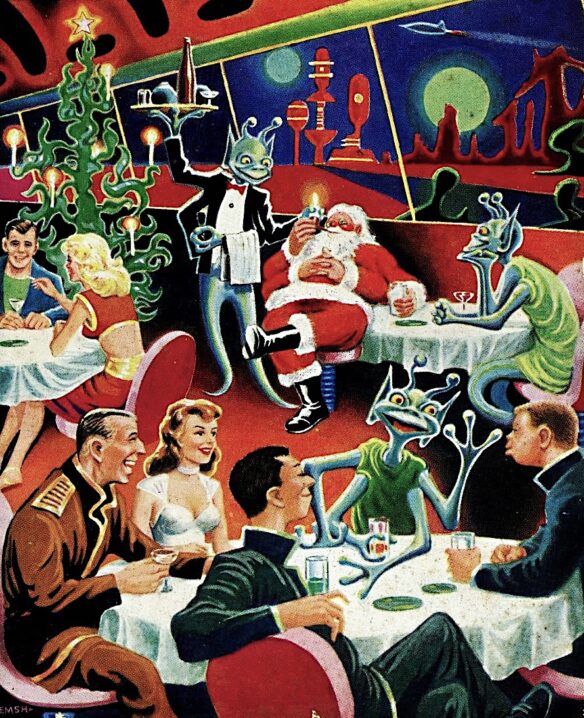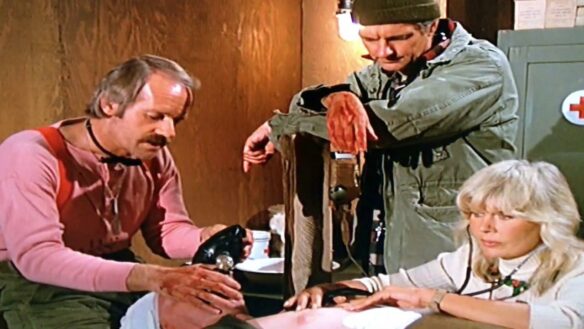(1) SCROLL LITE. I’m spending Christmas with my brother and his wife today, so this will be a short edition of the Scroll. I wish a happy holiday season to all of you!
(2) ‘TIL NEXT YEAR. Santa’s finished his rounds and can relax at his favorite intergalactic watering hole. (An Emsh cover for Galaxy Magazine.)

(3) DOCTOR BARBIE. [Item by SF Concatenation’s Jonathan Cowie.] It’s Christmas and some science journals have festive light-heartedness…
The cover of the British Medical Journal (BMJ) relates to the fantasy film hit of the year Barbie. “Christmas 2023: Ideas for a new world”.
The cover of The BMJ’s Christmas issue this year shows a Barbie that challenges sexist and racist norms. Richard Hurley describes the other new ideas this Christmas issue presents.

See also: “This Barbie is a surgeon”.
In her elegant qualitative study, Katherine Klamer dares the reader to dream bigger for a rising generation of girls.1 In an analysis of nearly 90 Barbies, Klamer found that Barbie brand medical professional dolls largely treated children (63%, n=48/76), with only three dolls (4%, n=3/76) working with adults. 59% of the Barbie brand dolls were white, 28% black, and 6% East Asian, and none had any physical disabilities. All Barbie brand doctors appeared to have either no specialization or were paediatricians with no apparent sub-specialization. Analysis showed that the dolls’ personal safety accessories were inadequate for standard practice; 98% of the Barbie brand dolls came with stethoscopes yet only 4% had face masks. Overall, the group of Barbies showed only a very limited range of medical careers.1 As surgeons in decidedly male dominated fields, we support Klamer’s conclusion that Barbies should represent a more diverse field of medical and scientific professions and that safety comes before fashion. Surely, personal protective equipment (known as PPE) should be commonplace accessories in medical and scientist Barbies’ wardrobes. While the evolution of Barbie’s career options has expanded in recent decades, there is clearly still room for improvement….
The issue also includes an article about “The space doctors”
Few doctors get to go on real space missions, but they do conduct space research, often in extreme…
What do you actually do on a mission?
SR: “You’re trying to simulate the conditions in an environment like the Moon or Mars or anywhere in space so that you can test out technologies and see how they stand up and whether they’re appropriate to be used by a group of isolated people. But you also train future astronauts.”
RV: “When I started in analogue missions (where researchers carry out field tests in places with physical similarities to space environments1 ) there was me and two other doctors in the whole discipline and that was it. Now analogue space medicine has grown into a bigger specialty, and I think that may be because of the Lunar Gateway (the planned extraterrestrial space station to orbit the Moon) plus multiagency/international collaboration planning an extraterrestrial space station on Mars. For that we need to have more testbeds for doing what we call ‘quick, fast, and fail’ to learn what works. To do that you need analogues.”…
(4) MEMORY LANE.
[Written by Cat Eldridge.]
1980 — I assume most of you are familiar with the M*A*S*H series that ran eleven seasons starting in 1972. Based off of the Robert Altman film of the same name, it was supposed to be a comedy but a lot of very dark humor, pathos, tragedy and even quite moving deaths got in it as well.
It did three Christmas-centered episodes of which I think only “Death Takes A Holiday” from the ninth season stands up as a truly interesting story.
The secondary story which I’ll detail first has Charles Emerson Winchester the Third, our insufferable Bostonian surgeon, refusing to help salvage things after a party for orphans is cancelled. Everyone else digs into their rations from home and puts together a true military style Christmas party, but him.
It turn out that Emersons don’t do public charity and he had given expensive chocolate that he got from his parents to that orphanage instead. Thus he’s understandably angry when he discovers the chocolate had made its way to the black market. So he takes the director aside and shouts at him, but the director says the candy was better used to purchase rice and cabbage, which the kids needed far more than candy.
So now for the main story.
A soldier shot by a sniper is choppered in on Christmas. It’s clear that there’s absolutely no hope of saving him as the surgeons know he is brain dead and will die no matter what they do. Just as they’re dropping life saving measures, they find a photograph of his family.
So Hawkeye, B.J., and Margaret decide to keep him alive, not indefinitely as not cannot happen even as a Christmas miracle, just until December 26th, so his family will never have to think of Christmas as the day their husband and father died. They succeed until after late evening, but he doesn’t make it to midnight. Finally, Hawkeye makes the decision to push the hands past midnight, and they agree to the list his time of death as early the next morning.
So no Christmas miracles, just a lie that will help a family be just a little more happy come the next Christmas. Maybe.
As our medical staff leave the dead behind and Father Mulcahy has administer the Last Rites, they are greeted by Potter as Santa. Potter says Santa knows they’ve “been very good boys and girls today” and has an elf, one of the orphans, give them the last four pieces of nurse Peg’s mother’s fudge from California.
Snow begins falling as they each take a piece and toast each other with it, wishing each other a Merry Christmas while the M*A*S*H staff in the Mess Tent sing the last lines of “Silent Night”.
Writing episodes was never a solitary enterprise for the series, so this episode was written by Mike Farrell, John Rappaport, Dennis Koenig, Thad Mumford, Dan Wilcox, and Burt Metcalfe and directed by Farrell. Mike Farrell played Captain B.J. Hunnicutt on the series.
Colonel Potter here became the third and final member of the 4077th to play Santa Claus, after Hawkeye in “Dear Dad”, and B.J. in “Dear Sis”.

(5) TODAY’S BIRTHDAY.
[Written by Cat Eldridge.]
Born December 25, 1924 — Rod Serling. (Died 1975.) Rod Serling is best remembered for the original and certainly extraordinary Twilight Zone series and its sequel series of sorts Night Gallery, with the former winning an impressive three Hugos. He was involved at some stage in Seven Days in May, as well as The New People series, The Strange Case of Dr. Jekyll and Mr. Hyde, UFOs: Past, Present, and Future and Planet of the Apes.

So let’s look at that work I listed above which is other than Twilight Zone and Night Gallery and what Serling had to do with them, if anything.
Let’s start Seven Days in May, a very scary film indeed, which first in released in 1964. Director John Frankenheimer hired Serling to write the script off the novel of the same name by Fletcher Knebel and Charles W. Bailey II. It’s a solid piece of alternative history.
The New People series isn’t really anything he was involved in despite many websites listing him as being so. He was given the idea by Aaron Spelling about a group of young people who crash-land on a remote island and with everyone thinking they’re dead, they set out to form a new society.
He said in a later interview that “He brought me the idea and I wrote the pilot script. Beyond that, I have nothing to do with it. The show is somewhere between Gilligan’s Island and San Francisco State. It may work. But not with me.” The original never-aired fifty-one minute pilot was screened at UCLA Film & Television Archive with a full Serling credit eleven years ago.
Now Serling again had nothingwith the final aired version of The Strange Case of Dr. Jekyll and Mr. Hyde film. He was hired to write the script when it was to film in London but Jason Robards was unhappy with his script so it was moved because of a strike to Toronto and a new script by a new writer done. No idea what happened to that script. A pity as it might’ve been interesting.
UFOs: Past, Present, and Future was narrated by Rod Serling, Burgess Meredith, and José Ferrer who had been involved in The Twilight Zone. A documentary purportedly proving they were real. It is various claimed that officials at California’s Norton Air Force Base, the U.S. Department of Defense or the National Republican Party asked for this film. Serling had no role in it beyond narrating part of it.
Planet of the Apes is an interesting story as the script he wrote was then modified by subsequent screenwriters. Even Serling himself disputes that much of his script remains in the final shooting script saying “The original script that I wrote was considerably different than the one they ultimately used” and whether iconic visual aspects of the film such as the hand of The Statue of Liberty were solely his idea.
So The Twilight Zone and The Night Gallery which I just checked to make sure and yes Paramount + is still streaming the original Twilight Zone.
The Twilight Zone as created, largely written by and presented by Rod Serling premiered on CBS with the “Where is Everybody?” episode sixty-four years ago. An earlier pilot was developed but it ended up airing on a different show, Westinghouse Desilu Playhouse, and was later adapted as a radio play. Serling served as executive producer and head writer; he wrote or co-wrote ninety-two of the show’s one hundred and fifty-six episodes.
The series would run four seasons in total. It would win the Hugo at Pittcon and then again the next year at Seacon for Best Dramatic Presentation repeating that for a third year straight at Chicon III. It didn’t do that for a fourth year running at DisCon I as no Best Dramatic Presentation Hugo was awarded.
Some of my favorite episodes? “Five Characters In Search of an Exit” for its minimalistic approach to, well, everything; “Nightmare at 20,000 Feet” with Shatner of course which was actually written not by Serling but by Richard Mathewson; “The Mighty Casey” and “I Sing The Body Electric”, an episode based on a story by Ray Bradbury. Although Bradbury contributed several scripts to the series, this was the only one produced.
Now for The Night Gallery. Unlike The Twilight Zone which has seeped into my consciousness and into my bones as well, I’ll willingly admit that although I’ve watched bits and pieces of it down the decades that I won’t say that’s it has gotten a firm hold on my consciousness like its predecessor. I think it’s that I’m just not interested in horror and suspense which was its focus, so what I saw just didn’t interest me the way the stories on The Twilight Zone always did. It’s not just as pure a storytelling experience for me as that series is. Oh well.

(6) COMICS SECTION.
Tom Gauld brings back a couple of his Good King Wenceslas variations.
(7) WHO WAS THAT MASKED DOG? CBR.com tells how “Batman: Ace the Bat-Hound Received an Award-Winning New Christmas Origin”.
It’s our yearly Comics Should Be Good Advent Calendar! This year, the theme is the Greatest Christmas Comic Book Stories Ever Told! I had you all vote for your all-time favorite comic book Christmas stories and I collected all the votes, and now I am counting down the results! Each day will spotlight the next story on the list as we count down from #24 all the way to #1!
Every day until Christmas Eve, you can click on the current day’s Advent Calendar post, and it will show the Advent Calendar with the door for that given day opened, and you can see what the “treat” for that day will be! You can click here to see the previous Advent Calendar entries.
And now, we open the sixteenth door on the calendar…

Who was the original Ace the Bat-Hound?
The best thing about Ace the Bat-Hound (created by Bill Finger, Sheldon Moldoff and Charles Paris) is that originally he wasn’t even Batman and Robin’s DOG!
When he debuted in 1955’s Batman #92, he was just a dog that they found with a distinctive mark on his forehead and Bruce Wayne advertised in the local newspaper that he found the dog. The dog then jumped into the Batmobile while Batman and Robin were on the way to a crime scene, and since Batman and Robin couldn’t very well be seen hanging around with the same dog that Bruce Wayne just advertised that he had found, Robin made him a mask to cover the distinctive mark, and so Ace the Bat-Hound made his debut!…
[Thanks to Steven French, Kathy Sullivan, Mike Kennedy, Andrew Porter, John King Tarpinian, Chris Barkley, Cat Eldridge, and SF Concatenation’s Jonathan Cowie, for some of these stories. Title credit belongs to File 770 contributing editor of the day Andrew (not Werdna).]
Discover more from File 770
Subscribe to get the latest posts to your email.

First? Happy whatever day!
I just finished reading one of my favorite Niven stories, “All the Myriad Ways” which you can find in the collection of the same name. It reminded that despite the fact that I find his longer fiction often disappointing that is never true of any of the shorter fiction that he has written.
And I thought it had been nominated for Hugo and indeed it had at St.Louiscon. It lost to Ellison’s “The Beast That Shouted Love at the Heart of the World”.
(1) Happy holidays to all! I celebrated by visiting my brother and his wife (for the first time in several years). Then, I visited my mother in the hospital. We’re hoping she will be released to rehab soon.
(2) Those covers are the best!
(5) I’m always sad when I remember that Rod Serling was just 50 when he died. It also makes it even more amazing that he accomplished so much.
This might be a good night to read one of those Christmas mystery anthologies I recently acquired (edited by Martin Edwards). Or that new Mercedes Lackey book I snagged…
(2) But aren’t you waiting for Hogfather?
(3) My primary care doctor is black, and wears a hijab.I like her a lot.
(4) The difference between Charles and Frank is that Frank was not just a jerk, but a lousy surgeon. Charles really was almost as good as he thought he was, and that he could save lives Frank would have lost bought him a lot.
Anne Marble says I’m always sad when I remember that Rod Serling was just 50 when he died. It also makes it even more amazing that he accomplished so much.
He’s a particularly tragic case because there’s no doubt that his extremely heavy smoking habit of three to four packs per day lead to his death.
He had a heart attack that required a two week in-hospital stay, than another heart attack after his release, that one much worse. They agreed that open heart surgery was needed, a very risky procedure then, and they did it but he coded on the table. They revived him but he only lived two more days.
@mark:Larry Linville on the other hand was actually a charming guy (judging from his visit to my college in the 1980s).
Scrollicide is Pixelless
Rod Serling had considerably less control over “The Night Gallery” than he did with
“The Twilight Zone”. After the series began he found that many of his proposed stories and scripts were ignored or rewritten by others. The Network and the Producers mainly wanted Serling to do Hosting duties and introduce the playlets. He made a good deal of money from “The Night Gallery” but was disappointed with the show itself.
PBS did a great job saluting Rod Serling’s life and work in the American Masters episode “Rod Serling, Submitted For Your Approval” which is produced as though it was an episode of “The Twilight Zone”
The Youtube Channel, The Hollywood Graveyard did a nice tribute to all the creative people who worked on “The Twilight Zone” for the show’s 60th Anniversary year in 2019:
Thomas the Red says Rod Serling had considerably less control over “The Night Gallery” than he did with “The Twilight Zone”. After the series began he found that many of his proposed stories and scripts were ignored or rewritten by others. The Network and the Producers mainly wanted Serling to do Hosting duties and introduce the playlets. He made a good deal of money from “The Night Gallery” but was disappointed with the show itself.
Yeah I read that preparing that Birthday. The behind the scenes politics of Night Gallery was a mess to put it very politely. The network very obviously didn’t want the darkness that was emblematic of the Twilight Zone and they crafted a series that wasn’t.
As you note, Serling wasn’t happy but the money was good. And Twilight Zone had been his only successful series. So money was always a concern for Serling…
Happy holidays to all!
Oh, heck, Cat, you’re telling me Rod Serling, whose work my dad loved, who was born just two years earlier than my dad, also died just two years later, of the same cause, in remarkably similar circumstances, because he was also a chain smoker?
There’s something both weirdly appropriate and deeply wrong about that.
I am back to feeling just my normal aches and pains. Which is…good?
Lis Carey says Oh, heck, Cat, you’re telling me Rod Serling, whose work my dad loved, who was born just two years earlier than my dad, also died just two years later, of the same cause, in remarkably similar circumstances, because he was also a chain smoker?
There’s something both weirdly appropriate and deeply wrong about that.
You have my deepest sympathies as that’s precisely what happened.
It’s extremely likely that Serling had less severe heart attacks previously, possibly as young as in his late twenties. .
I am back to feeling just my normal aches and pains. Which is…good?
As we’ve discussed elsewhere, yes.
I’m overdue for my every six months series of lubricants into my right knee that’s had three surgeries and needs two more eventually. Those are scheduled next month along with the other ten appointments I’ve got.
I vaguely remember that the MASH novel on which the series was based portrayed, all the doctors as competent, but that in the series both Frank Burns and Henry Blake are screw-ups, eventually replaced by more effective people. The series thus changed how it presented the MASH.
I much preferred Charles to Frank, as Charles was an opponent worth everyone’s steel.
Andrew (not Werdna)
I understand that most of the cast and crew of MASH thought that Larry Linville should have won an Emmy for playing Frank Burns because, much like Carrol O’Connor and Archie Bunker, Larry was personally the complete opposite of Frank, and the change in him assuming the character when the director said “Action” was remarkable.
@JeffWarner: Thanks. At the talk I saw, the hosts gave Linville a sweater from our college as a gift, and someone in the audience shouted “put it on like Frank” – and he did, shifting to Frank’s awkward body language instantly